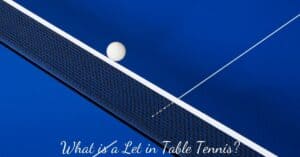Knowledge of the rules of scoring in table tennis may not be important when you are playing for fun or enjoyment. At the time of an argument on a point, you and your opponent may debate and ultimately come to a conclusion. That means you make your own rules in table tennis.
But it is essential to know the rules of scoring in table tennis when you are in a competitive match. It may be at the club level, in the district, in the state, or in any tournament that follows the scoring rules governed by the International Table Tennis Federation (ITTF).
Before going into the details, let’s review some basic definitions related to scoring.
- A rally is the period when the ball is in play.
- A ‘let’ is a rally that ends with no result.
- A point is the result of a rally
- The server is the player who strikes the ball first in a rally.
- A receiver is a player who strikes the ball second in a rally.
- The umpire is the person who regulates the match.
- The assistant umpire is the person who assists the umpire on certain decisions.
Now come to the question:
How to Score in Table Tennis
To keep scoring in table tennis, you have to earn points. It’s simple. But to earn points, you have to follow certain rules.
Service Rules in Table Tennis
You have to follow the service rules to keep scoring. An illegal serve gives your opponent the benefit of getting a free point. That will hurt you in a match and your mindset will be disturbed. I am giving a brief idea of the serving rules in table tennis.
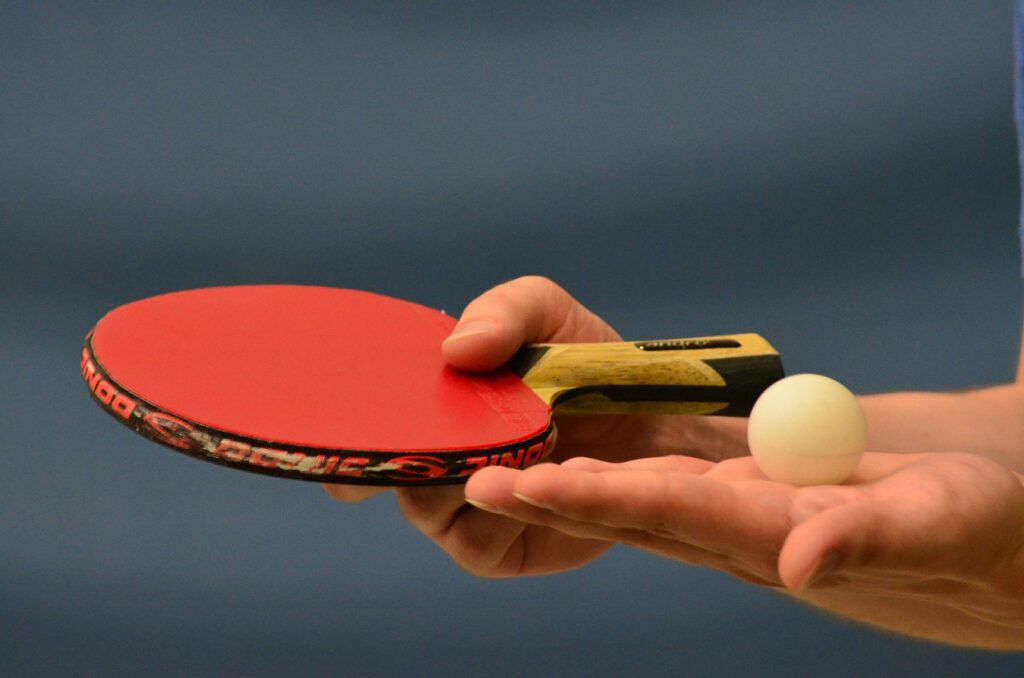
- At the time of service, keep the ball on your open flat palm. Don’t hold the ball with your fingers.
- Throw the ball almost vertically for a minimum height of 16 cm (6.3 inches).
- Don’t impart spin to the ball at the time of throwing.
- Don’t hide the ball during service.
- Start the service with the ball behind the End Line and above the surface of the table.
- For a valid service, the first bounce of the ball must be on your side, and the second bounce on the opponent’s side after crossing cleanly over the net.
- In doubles, the first bounce must be on the right half of the table, and the next bounce on the right half of your opponent’s side, which is diagonal to your side.
Make a Valid Return to Continue the Rally
When you are returning the ball, strike the ball after the first bounce. Don’t allow the ball to bounce twice on your side. Your return may clip the net before bouncing on the opponent’s side or it may touch the edge of the table but not the vertical side of the table.
What is the Order of Play in a Rally?
At first, the server does the service, then the other player gives his return. After that, the server becomes the receiver and tries to make his return. This alternate sequence of returning the ball continues till the rally ends.
In the doubles game, after your service, the receiver becomes the next server and your partner becomes the receiver. This sequence continues, till the game ends.
What is Let in Table Tennis?
“Let” is the situation when a rally is interrupted and you have to serve again. In many circumstances, an umpire may call “let”.
- The ball must pass cleanly over the net. If the ball touches the net and still bounces on the other side, then it is “let in table tennis” and you have to serve again.
- You deliver the service, but your opponent is not ready to react.
- If the umpire or the assistant interrupts during a match.
- If you fail to deliver a service or a return due to some outside occurrence that is beyond your control, then the umpire may call it “let”.
- There is no rule on the number of consecutive ‘let’ services. So, there is no limit on let service in table tennis. If your service is legal, you will always get the chance to serve again.
How Many Points Do You Need to Win a Table Tennis Game?
When you win in a rally, you get a point. The server gives 2 consecutive services and the opponent tries to return the ball. Then it is the turn of the receiver, he gives 2 consecutive services.
The game continues until any one of the players reaches 11 points. The game ends with the score at 11 points and the first player who reaches 11 points, wins the game. But in this scoring system in table tennis, there is an exception, which is:
What is Deuce in table tennis?
If the game reaches a situation of 10-10 score, i.e. both the players have 10 points each, it is called “Duece in table tennis“. In this stage of equality, a two-point lead is a must for winning the game.
How Many Games Are There in a Table Tennis Match?
A match consists of the best of any odd no. of games, it may be 3 games, 5 games, or 7 games.
What are the Situations when a Player Fails to Score?
You score a point if your opponent mis-hits the ball, i.e. the ball does not bounce on your table. The same is true for your opponent.
These are the situations when a point will not be given in your favor.
- You fail to deliver a legal table tennis serve.
- You miss the service.
- If the ball goes over the table in your service.
- After one bounce, you fail to hit the ball i.e. allow more than one bounce.
- You fail to keep the ball on the table of your opponent.
- You hit the ball twice in succession.
- In the doubles match, you hit the ball out of your turn.
- You obstruct the ball with your body or cloth.
- You move the table and touch the net or table with your free hand during a match.
How to Indicate Score in Table Tennis
When a player wins a point, the umpire uses the following system to indicate the score of the game.
- The umpire calls the score as soon as the ball is out of play in a rally.
- When the umpire calls the score, he or she first calls the number of points of the player who is due to serve in the coming rally and then calls the point of the other player.
- After the game, the umpire calls the points of the winner followed by the loser.
- In addition to calling, the umpire may use the hand signal to indicate his or her decision.
- The umpire raises his arm nearer to the winning player. His upper arm is horizontal and the forearm is vertical with a closed hand.
- Whenever a rally is ‘let’, the umpire raises his or her hand to indicate that the rally has ended.
What is a Table Tennis Scoreboard?
During the match, both the players and spectators need to visualize the score to keep tracking the winner of the match. For this, a scoreboard is used for recording and displaying the scores. The scoreboard may be a mechanical type or a digital type.
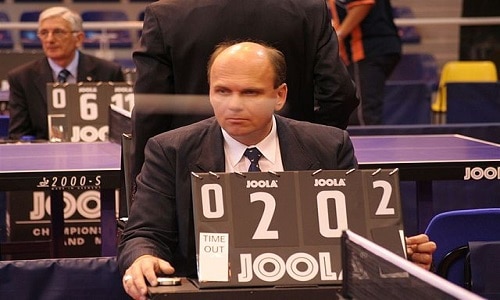
Wikimedia Commons, CC BY-SA 2.0
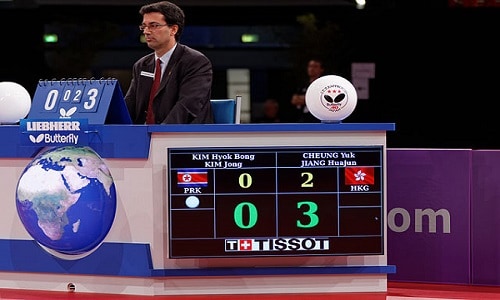
Wikimedia Commons, CC BY-SA 3.0
In the mechanical type scoreboard, a person is appointed to flip the number cards. With the advance of new technology, the digital scoreboard is more popular nowadays where an electronic indicator is used to show the score to the players and spectators.
What are “Ping Pong Rules 21 Points”?
When it comes to the recreational version of table tennis, the “Ping pong rules 21 points” applies to the game.
In ping pong, the player who reaches first at 21 points, wins the game. But there must be at least a 2-point lead over his opponent.
If both the players reach 20 points i.e. when the score is 20-20, it is a deuce in ping pong. A 2-point lead is a must to win the game. The first player, who gets a 2-point lead wins the game. A match is the best of 2 out of 3 games in ping pong.
What is The Expedite System?
In the Expedite system in table tennis, a game is interrupted by the umpire even if the ball is in play and the game resumes with a new set of rules.
- The Expedite system will come into operation if the game goes longer than 10 minutes and the score is less than 18 points.
- If the ball is in play, the game will resume with the service of the player who was the server at the time of interruption by the umpire.
- If the ball is not in play, the game will resume with the service of the player who was the receiver in the preceding rally.
- After the Expedite system comes into operation, each server will serve once instead of two.
- After the return of the receiver, the assistant will shout counting the no. of returns. Suppose, the receiver makes 5 good returns, then after the 5th return, the assistant umpire will shout “five”.
- If the receiver gives 13 correct returns, he will get the point.
- Once introduced, the Expedite system will continue till the end of the match. Suppose a match is going on with the best of 5 games. If the Expedite system is introduced in the second game, the rest three games will also follow the Expedite system.
Today’s table tennis is mainly dominated by attackers. So in this fast-paced game, the Expedite system is very rare in table tennis.
